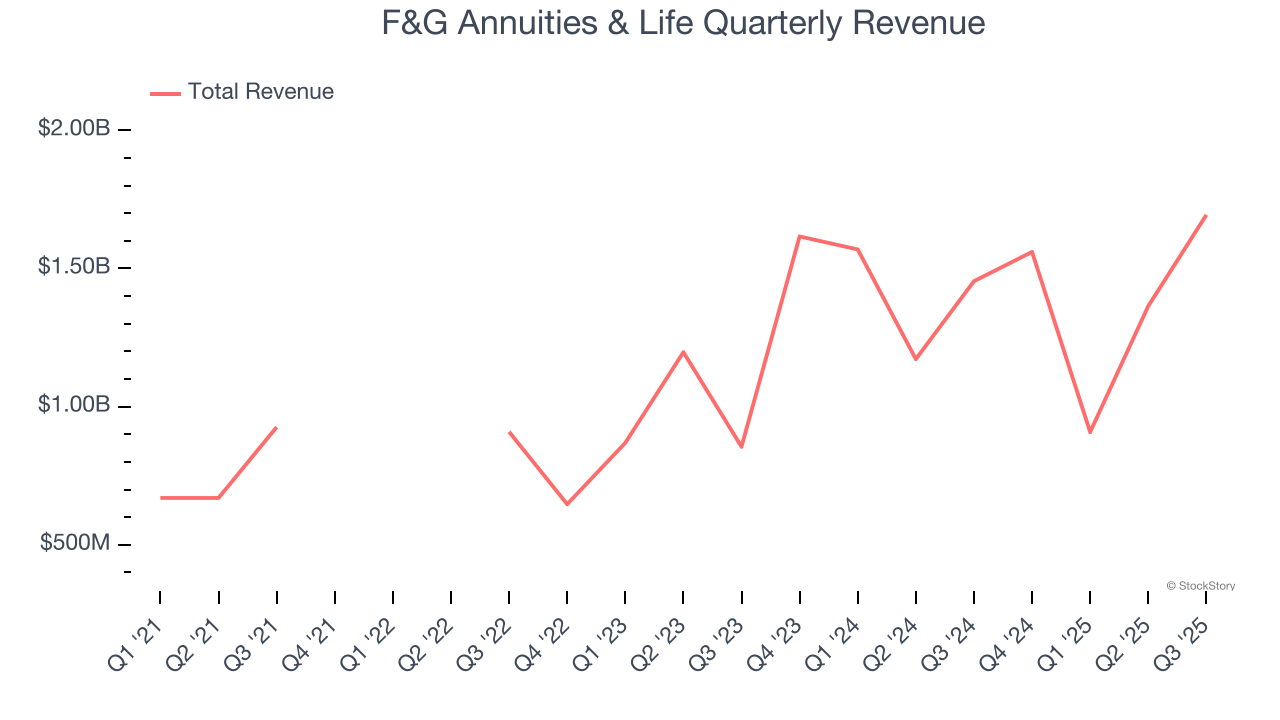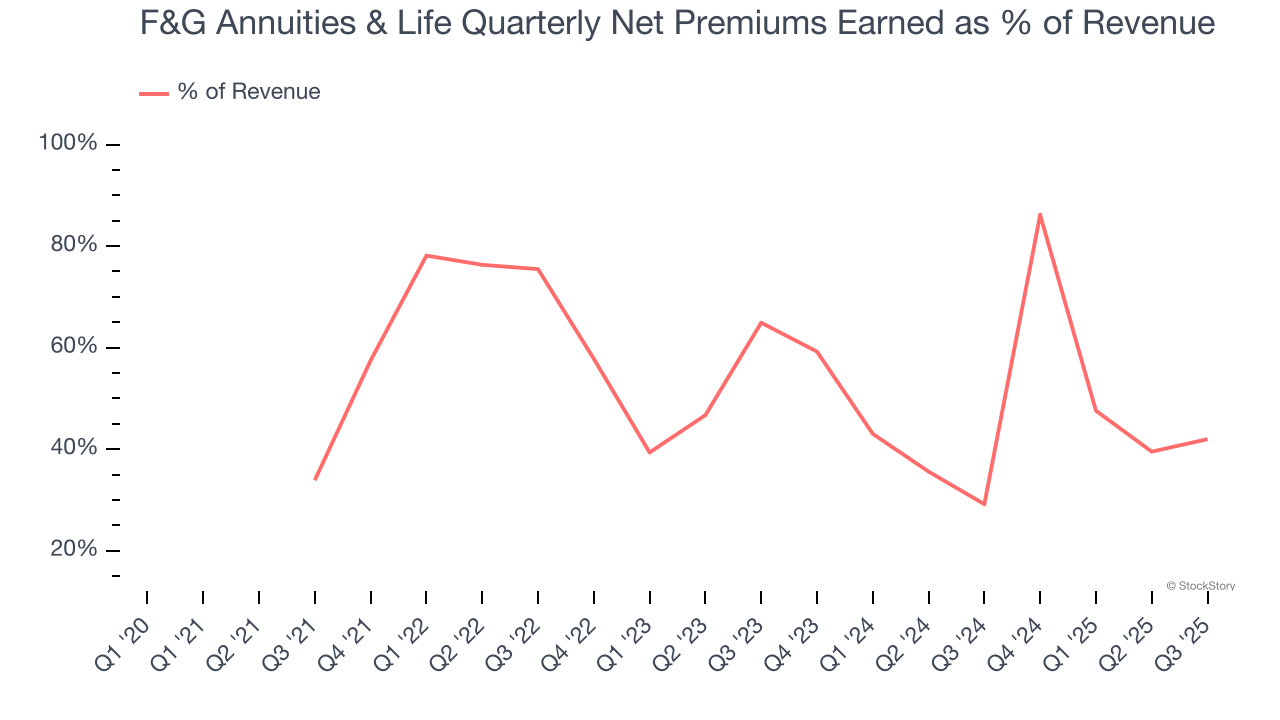
Insurance solutions provider F&G Annuities & Life (NYSE: FG) reported Q3 CY2025 results beating Wall Street’s revenue expectations, with sales up 16.5% year on year to $1.69 billion. Its non-GAAP profit of $1.22 per share was 25.4% above analysts’ consensus estimates.
Is now the time to buy F&G Annuities & Life? Find out by accessing our full research report, it’s free for active Edge members.
F&G Annuities & Life (FG) Q3 CY2025 Highlights:
Chris Blunt, F&G's Chief Executive Officer, said, "We delivered outstanding third quarter results highlighted by record assets under management before flow reinsurance of $71 billion fueled by one of our best sales quarters in history, the launch of our new reinsurance sidecar, and strong performance across our business through the third quarter as we execute on our strategy and make continued progress towards our 2023 Investor Day targets. Our business continues to benefit from increased scale and disciplined expense management, as our ratio of operating expense to AUM before flow reinsurance has improved to 52 basis points, down 10 basis points from the third quarter of 2024, with further improvement expected by the end of the year. Our high quality investment portfolio is performing well and credit related impairments remain below our pricing assumption. F&G is becoming a more fee based, higher margin and capital light business as we leverage our position as one of the industry's largest sellers of annuities and life insurance."
Company Overview
Founded in 1959 and serving approximately 677,000 policyholders who rely on its financial protection products, F&G Annuities & Life (NYSE: FG) provides fixed annuities, life insurance, and pension risk transfer solutions to retail and institutional clients.
Revenue Growth
In general, insurance companies earn revenue from three primary sources. The first is the core insurance business itself, often called underwriting and represented in the income statement as premiums earned. The second source is investment income from investing the “float” (premiums collected upfront not yet paid out as claims) in assets such as fixed-income assets and equities. The third is fees from various sources such as policy administration, annuities, or other value-added services. Luckily, F&G Annuities & Life’s revenue grew at an incredible 15% compounded annual growth rate over the last four years. Its growth surpassed the average insurance company and shows its offerings resonate with customers, a great starting point for our analysis.
 Note: Quarters not shown were determined to be outliers, impacted by outsized investment gains/losses that are not indicative of the recurring fundamentals of the business.
Note: Quarters not shown were determined to be outliers, impacted by outsized investment gains/losses that are not indicative of the recurring fundamentals of the business.Long-term growth is the most important, but within financials, a stretched historical view may miss recent interest rate changes and market returns. F&G Annuities & Life’s annualized revenue growth of 24.4% over the last two years is above its four-year trend, suggesting its demand was strong and recently accelerated.  Note: Quarters not shown were determined to be outliers, impacted by outsized investment gains/losses that are not indicative of the recurring fundamentals of the business.
Note: Quarters not shown were determined to be outliers, impacted by outsized investment gains/losses that are not indicative of the recurring fundamentals of the business.
This quarter, F&G Annuities & Life reported year-on-year revenue growth of 16.5%, and its $1.69 billion of revenue exceeded Wall Street’s estimates by 20.8%.
Net premiums earned made up 48.8% of the company’s total revenue during the last five years, meaning F&G Annuities & Life’s growth drivers strike a balance between insurance and non-insurance activities.
 Note: Quarters not shown were determined to be outliers, impacted by outsized investment gains/losses that are not indicative of the recurring fundamentals of the business.
Note: Quarters not shown were determined to be outliers, impacted by outsized investment gains/losses that are not indicative of the recurring fundamentals of the business.Net premiums earned commands greater market attention due to its reliability and consistency, whereas investment and fee income are often seen as more volatile revenue streams that fluctuate with market conditions.
Microsoft, Alphabet, Coca-Cola, Monster Beverage—all began as under-the-radar growth stories riding a massive trend. We’ve identified the next one: a profitable AI semiconductor play Wall Street is still overlooking. Go here for access to our full report.
Book Value Per Share (BVPS)
Insurers are balance sheet businesses, collecting premiums upfront and paying out claims over time. Premiums collected but not yet paid out, often referred to as the float, are invested and create an asset base supported by a liability structure. Book value per share (BVPS) captures this dynamic by measuring these assets (investment portfolio, cash, reinsurance recoverables) less liabilities (claim reserves, debt, future policy benefits). BVPS is essentially the residual value for shareholders.
We therefore consider BVPS very important to track for insurers and a metric that sheds light on business quality because it reflects long-term capital growth and is harder to manipulate than more commonly-used metrics like EPS.
To investors’ benefit, F&G Annuities & Life’s BVPS grew at an incredible 33.9% annual clip over the last two years.

Over the next 12 months, Consensus estimates call for F&G Annuities & Life’s BVPS to grow by 48.4% to $46.03, elite growth rate.
Key Takeaways from F&G Annuities & Life’s Q3 Results
It was good to see F&G Annuities & Life beat analysts’ EPS expectations this quarter. We were also excited its net premiums earned outperformed Wall Street’s estimates by a wide margin. On the other hand, its book value per share missed. Overall, we think this was a decent quarter with some key metrics above expectations. The stock remained flat at $29.87 immediately following the results.
So do we think F&G Annuities & Life is an attractive buy at the current price? The latest quarter does matter, but not nearly as much as longer-term fundamentals and valuation, when deciding if the stock is a buy. We cover that in our actionable full research report which you can read here, it’s free for active Edge members.






